Note that the alpha factors are "only" the effect for the element by another element. To convert the alpha factors to a matrix correction, or "beta" factors as they are usually referred to, one must compound them using the method described in the attached poster below.
Why, because we need to include the effect of the element by itself as an absorber, which is 1.0 by definition of course. So we need to take the fraction of the Fe-Ga binary but also the fraction of the Fe-Fe and Ga-Ga binaries which again by definition are 1.0.
But to take an example using CalcZAF we can enter a nominal FeGa 50:50 wt% compound as seen here:
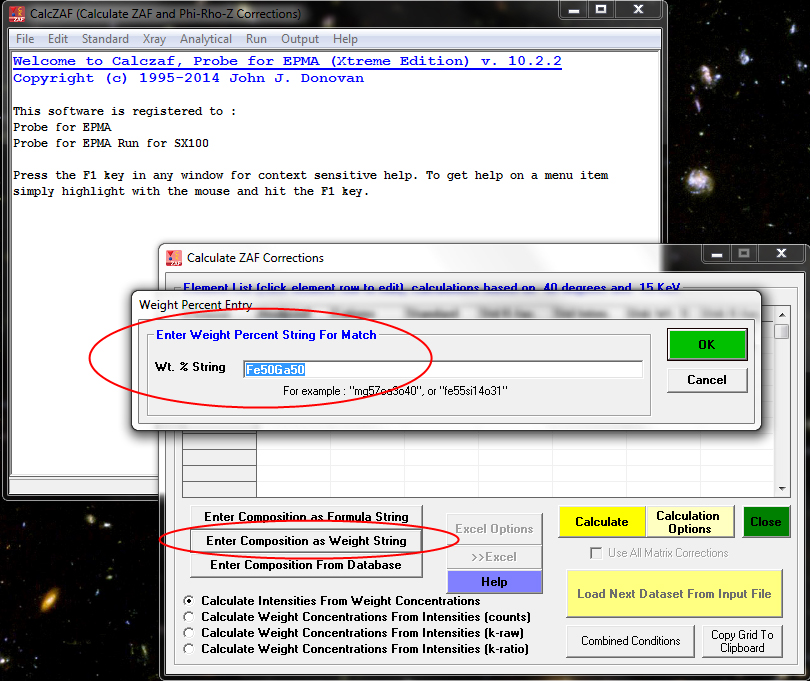
We also need to enter 20 keV in the Analytical |Operating Conditions menu. Then we click the Calculate button:
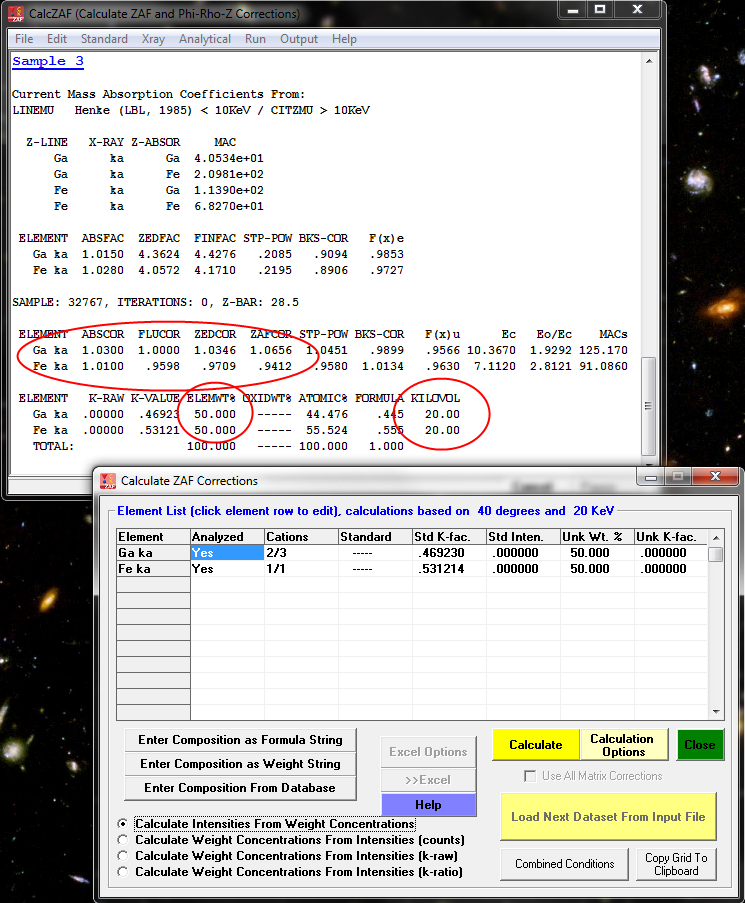
Again we see a significant fluorescence for Fe Ka and significant absorption for Ga Ka. Let's change things up by switching to alpha-factor calculations from the Analytical | ZAF, Phi-Rho-Z, Alpha factor and Calibration Curve Selections menu.
This way we can see the same k-ratios from our Armstrong/Reed analytical model expressed as polynomial fit alpha factors. First we select alpha-factors:
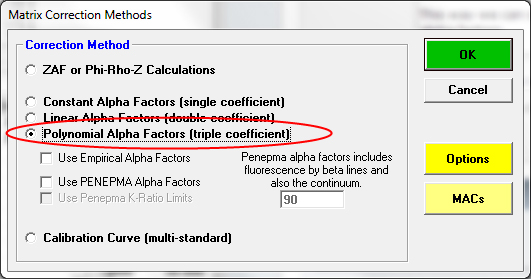
Then we click the Calculate button again and get much more output, finally this summary:
NON-LINEAR Alpha Factors, Takeoff= 40, KeV= 20
P=1, Pt#1, C=.9900, K=.9887, Alpha=1.1302
P=2, Pt#2, C=.9500, K=.9439, Alpha=1.1302
P=3, Pt#3, C=.9000, K=.8884, Alpha=1.1303
P=4, Pt#4, C=.8000, K=.7796, Alpha=1.1305
P=5, Pt#5, C=.6000, K=.5701, Alpha=1.1309
P=6, Pt#6, C=.5000, K=.4692, Alpha=1.1312
P=7, Pt#7, C=.4000, K=.3708, Alpha=1.1314
P=8, Pt#8, C=.2000, K=.1809, Alpha=1.1318
P=9, Pt#9, C=.1000, K=.0894, Alpha=1.1320
P=10, Pt#10, C=.0500, K=.0444, Alpha=1.1321
P=11, Pt#11, C=.0100, K=.0088, Alpha=1.1322
Xray Matrix Alpha1 Alpha2 Alpha3 %MaxDev
Ga ka in Fe 1.1322 -.0021 .0000 .00
P=1, Pt#1, C=.0100, K=.0118, Alpha=.8429
P=2, Pt#2, C=.0500, K=.0584, Alpha=.8485
P=3, Pt#3, C=.1000, K=.1151, Alpha=.8545
P=4, Pt#4, C=.2000, K=.2244, Alpha=.8640
P=5, Pt#5, C=.4000, K=.4317, Alpha=.8775
P=6, Pt#6, C=.5000, K=.5312, Alpha=.8825
P=7, Pt#7, C=.6000, K=.6285, Alpha=.8867
P=8, Pt#8, C=.8000, K=.8174, Alpha=.8937
P=9, Pt#9, C=.9000, K=.9094, Alpha=.8966
P=10, Pt#10, C=.9500, K=.9549, Alpha=.8979
P=11, Pt#11, C=.9900, K=.9910, Alpha=.8989
Xray Matrix Alpha1 Alpha2 Alpha3 %MaxDev
Fe ka in Ga .8437 .1021 -.0478 .22
St 3 Sample 3
TakeOff = 40.0 KiloVolt = 20.0 Density = 5.000
Standard Z-bar: 28.5
ELEM: Ga Fe
ELWT: 50.000 50.000
NRWT: 50.000 50.000
BETA: 1.0656 .9414
So these "beta" factors are essentially the matrix correction factors for this composition at 20 keV and as one can see they are very close to the pure Phi-rho-z calculations above.
Ga Ka 1.0656 compared to 1.0656
Fe Ka 0.9414 compared to 0.9412
Now it gets interesting. Let's now utilize the Penepma Penfluor/Fanal Fe-Ga binary k-ratios as alpha factors by checking this box here:
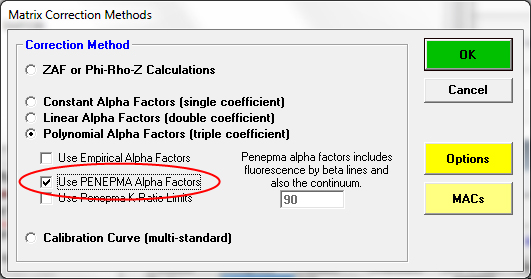
Now we click calculate again and here is our output, notice the k-ratios loaded from the matrix.mdb database:
Initializing alpha-factors...
Number of alpha-factor binaries to be calculated = 1
Calculating alpha-factor binary Ga ka in Fe
AFactorPenepmaReadMatrix: Ga ka in Fe at 40 degrees and 20 keV
Conc Kratios Alpha
99.0000 98.690285 1.31383
95.0000 94.231575 1.16309
90.0000 88.327248 1.18938
80.0000 77.508125 1.16075
60.0000 56.482689 1.15568
50.0000 46.362133 1.15693
40.0000 36.643017 1.15269
20.0000 17.789076 1.15536
10.0000 8.803622 1.15100
5.00000 4.372882 1.15096
1.00000 .870474 1.15030
AFactorPenepmaReadMatrix: Fe ka in Ga at 40 degrees and 20 keV
Conc Kratios Alpha
99.0000 99.153847 .844841
95.0000 95.536354 .887718
90.0000 90.900276 .900960
80.0000 81.657516 .898508
60.0000 62.794140 .888758
50.0000 53.077549 .884036
40.0000 43.177395 .877351
20.0000 22.564974 .857912
10.0000 11.565740 .849581
5.00000 5.906283 .838480
1.00000 1.207044 .826737
NON-LINEAR Alpha Factors, Takeoff= 40, KeV= 20
P=1, Pt#1, C=.9900, K=.9869, Alpha=1.3138
P=2, Pt#2, C=.9500, K=.9423, Alpha=1.1631
P=3, Pt#3, C=.9000, K=.8833, Alpha=1.1894
P=4, Pt#4, C=.8000, K=.7751, Alpha=1.1607
P=5, Pt#5, C=.6000, K=.5648, Alpha=1.1557
P=6, Pt#6, C=.5000, K=.4636, Alpha=1.1569
P=7, Pt#7, C=.4000, K=.3664, Alpha=1.1527
P=8, Pt#8, C=.2000, K=.1779, Alpha=1.1554
P=9, Pt#9, C=.1000, K=.0880, Alpha=1.1510
P=10, Pt#10, C=.0500, K=.0437, Alpha=1.1510
P=11, Pt#11, C=.0100, K=.0087, Alpha=1.1503
Xray Matrix Alpha1 Alpha2 Alpha3 %MaxDev
Ga ka in Fe 1.1623 -.1413 .2145 6.18
P=1, Pt#1, C=.9900, K=.9915, Alpha=.8448
P=2, Pt#2, C=.9500, K=.9554, Alpha=.8877
P=3, Pt#3, C=.9000, K=.9090, Alpha=.9010
P=4, Pt#4, C=.8000, K=.8166, Alpha=.8985
P=5, Pt#5, C=.6000, K=.6279, Alpha=.8888
P=6, Pt#6, C=.5000, K=.5308, Alpha=.8840
P=7, Pt#7, C=.4000, K=.4318, Alpha=.8774
P=8, Pt#8, C=.2000, K=.2256, Alpha=.8579
P=9, Pt#9, C=.1000, K=.1157, Alpha=.8496
P=10, Pt#10, C=.0500, K=.0591, Alpha=.8385
P=11, Pt#11, C=.0100, K=.0121, Alpha=.8267
Xray Matrix Alpha1 Alpha2 Alpha3 %MaxDev
Fe ka in Ga .8257 .2086 -.1624 3.33
St 1 Sample 1
TakeOff = 40.0 KiloVolt = 20.0 Density = 5.000
Standard Z-bar: 28.5
ELEM: Ga Fe
ELWT: 50.000 50.000
NRWT: 50.000 50.000
BETA: 1.0727 .9447
Close to the Armstrong/Reed analytical calculations but but little different. Which is is more correct? For these high energy lines I would say the Penfluor/Fanal calculations, but one would want to compare these calculations with measurements on standards.
By the way, any time one wants to know if the alpha factors are from the Penepma calculations or not, simply click the Run | List Current Alpha Factors menu here:
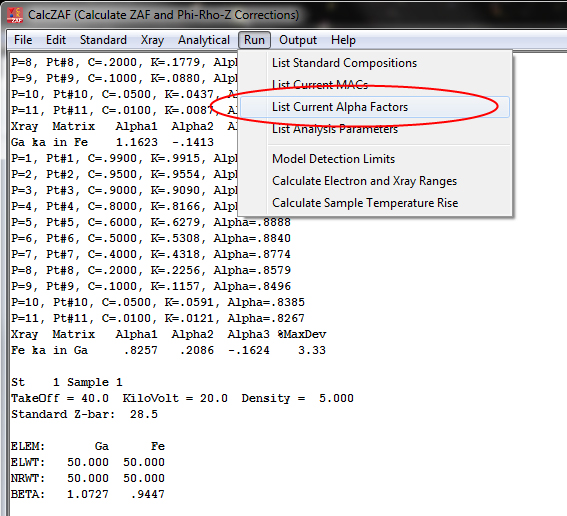
and then you will get output for all currently utilized binaries as seen here:
Penepma K-Ratio Alpha Factors:
Xray Matrix Alpha1 Alpha2 Alpha3
Fe ka in Ga .8257 .2086 -.1624 *From Penepma 2012 Calculations
Ga ka in Fe 1.1623 -.1413 .2145 *From Penepma 2012 Calculations
All Alpha Factors:
Ga Fe
Ga ka 1.0000 1.1623
Ga ka .0000 -.1413
Ga ka .0000 .2145
Fe ka .8257 1.0000
Fe ka .2086 .0000
Fe ka -.1624 .0000